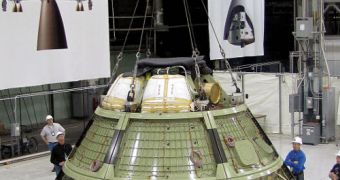Officials with Lockheed Martin announce that the company has just sent out the first Orion spacecraft structure today, out of the NASA Michoud Assembly Facility in New Orleans, Louisiana.
The vehicle is headed for Lockheed facilities situated in Denver, Colorado, where it will be put through a wide series of tests meant to assess its readiness for the harsh conditions of outer space.
This is the first crew module structure to be constructed for NASA in nearly three decades. This should have been a momentous occasion, had the program Orion belonged to not been canceled.
When Barack Obama became president of the United States, he proposed that the Bush-era Project Constellation be terminated, and the funds redirected to support the development of private space companies and of the commercial spaceflight industry.
Constellation included several components, such as the Altair lunar module, the Earth-Departure Stage (EADS) rocket, the ARES I, IV and V rockets and the Orion Crew Exploration Vehicle.
Under the new proposals, the space capsule was stripped down to its bare minimum. It is now being developed exclusively as a lifeboat for the International Space Station (ISS), in much the same way the Soyuz space capsules fulfill the same task.
But Lockheed Martin continued developing the spacecraft, and now the first one is nearly completed. After finishing its testing in Denver, the Orion platform will receive its thermal protection backshell and its heat shields, and will be put through even more tests.
After this stage of the integration is over, the capsule will be sent to the NASA Langley Research Center, in Hampton, Virginia. Once there, it will be tested in the Hydro Impact Basin, which is used to certify water landing capabilities for all manned NASA spacecraft.
“This is a significant milestone for the Orion project and puts us on the right path toward achieving the President’s objective of Orion’s first crewed mission by 2016,” explains the vice-president and Orion program manger at Lockheed, Cleon Lacefield.
“Orion’s upcoming performance tests will demonstrate how the spacecraft meets the challenges of deep-space mission environments such as ascent, launch abort, on-orbit operations, high-speed return trajectory, parachute deployment, and water landings in a variety of sea states,” he adds.
Headquartered in Bethesda, Maryland, Lockheed Martin is a global security company that employs about 132,000 people worldwide and is principally engaged in the research, design, development, manufacture, integration and sustainment of advanced technology systems, products and services.

 14 DAY TRIAL //
14 DAY TRIAL //